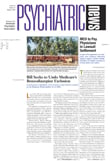The “gold standard” of clinical-trial design—randomized, double blind, and placebo controlled—may finally be on its way out. Long the regulatory requirement for pharmaceutical research, the randomized, controlled trial (RCT) is being replaced by the practical clinical trial (PCT).
“There is increasing notice on the federal level—at the Agency for Healthcare Research and Quality and the Centers for Medicare and Medicaid Services—of the need for solid evidence upon which to base policy decisions,” said Sandra Tunis, M.D., a senior research scientist at Eli Lilly and Co. in Indianapolis.
Tunis chaired a workshop at APA's 2005 annual meeting in Atlanta in May titled “Practical Clinical Trials: Comparing Effectiveness of Psychopharmacologic Treatments.”
While the standard RCT has long been used to bolster policy decisions stemming from evidence-based medicine, Tunis continued, “clinical researchers and regulators alike have long recognized that the majority of RCTs have limited generalizability and applicability to how clinicians treat the average patient seen in the medical office on a day-to-day basis.”
Indeed, studies have shown that the patient populations generally found in RCTs are quite different from the general patient populations found in real-world clinical settings.
The problem, Tunis noted—which is at once both the hallmark and the bane of the RCT—is the high degree of carefully controlled patient selection.
Patients who have a comorbid condition in addition to the primary condition being studied are generally excluded from RCTs. For example, an RCT studying the efficacy of an antidepressant medication for major depression would exclude patients with major depression who also have an anxiety disorder. RCTs on antipsychotics regularly exclude patients with psychosis who also have a substance abuse disorder, yet that comorbidity is extremely common in the real world. Also excluded from RCTs are psychiatric patients who have significant comorbidity of other medical disorders, such as cardiovascular disease or diabetes— again, common comorbidities in patients with psychiatric disorders.
“A practical clinical trial aims to max out the generalizability of the study,” Tunis explained. “PCTs commonly have minimal inclusion or exclusion criteria. In contrast, they specifically aim to enroll a wide range of patients from a range of clinical practices.”
While PCTs do have some form of randomization, they are not necessarily double blind and do not include placebo control groups. Rather, a group getting the treatment being studied is compared with a group receiving the“ usual care” for the disorder.
Inclusion Criteria Broad
Tunis was joined on the workshop panel by colleagues at Lilly, as well as Kurt Kroenke, M.D., a professor of internal medicine at Indiana University. Wayne Katon, M.D., a professor of psychiatry at the University of Washington Medical School, served as the discussant.
Kroenke described as an example of a PCT the ARTIST trial (A Randomized Trial Investigating SSRI Antidepressants). The ARTIST trial, for which Kroenke was the principal investigator, was published in the December 19, 2001, Journal of the American Medical Association. The trial enrolled more than 600 adults referred from 37 primary care clinics. The primary inclusion criterion was the primary care physician's clinical judgment that the patient had a new depressive episode that required treatment with an SSRI.
Patients were randomly assigned to receive paroxetine (Paxil), fluoxetine (Prozac), or sertraline (Zoloft). As a PCT, patients were allowed to switch medications, based upon their physicians' clinical judgment. By the end of the nine-month study, Kroenke said, only half of the patients had stayed with their originally assigned medication. There was progressive switching with a significant number of patients and some stopped treatment over time.
The ARTIST trial found no statistically significant differences on any of the trial's multiple outcomes. Depressive symptoms improved significantly in all three groups. Overall, 74 percent of patients in the three groups met criteria for major depression at baseline. By the end of the nine months, only 26 percent met those criteria.
“It simply didn't matter which drug they received,” Kroenke said. “All three medications were effective at relieving depressive symptoms.” However, costs differed between the three groups. Interestingly, residual symptoms were found to indicate a high risk for relapse and increased cost to the health care system.
Outcome Measures Include Cost
In contrast to standard RCTs, which traditionally focus only on efficacy or adverse effects, PCTs nearly always include measures of drug effectiveness, cost-effectiveness, and quality-of-life measures.
“In PCTs, the question becomes, Are there patient-level symptoms or measures of function that allow the clinician to see cost differences, based upon starting the patient on one drug versus another?” Katon said.“ In other words, can we make evidence-based, real-world formulary decisions based on individual patient characteristics that have an impact not only on treatment outcomes but also on cost?”
Katon believes the field is headed in the right direction, “but we are going to have to be creative in deciding which values or measures to incorporate into these trials in order to be able to collect the data we want.”
Workshop participants agreed that while progress has been made, outcome measures need to be developed that are disease specific and more sensitive to change in short-term as well as longer-term studies.
JAMA 2001 286 2947
